Museum of Arts & Design
Allied Works Architecture
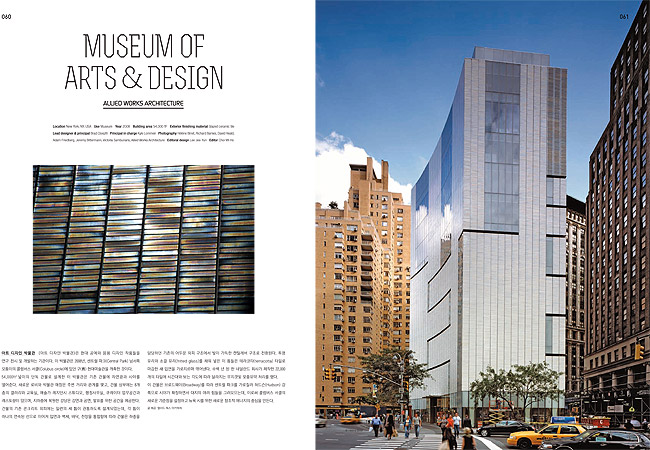
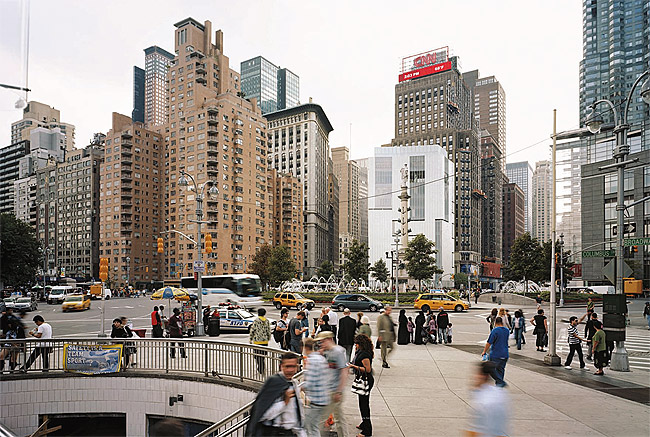
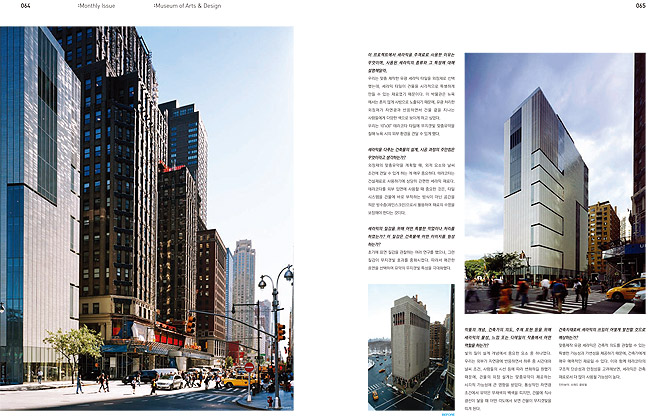
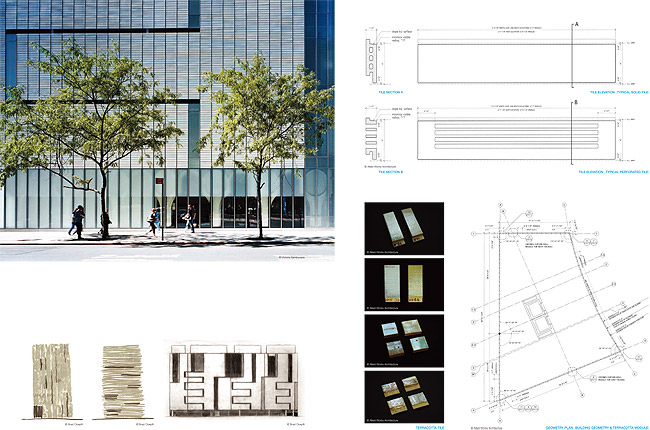
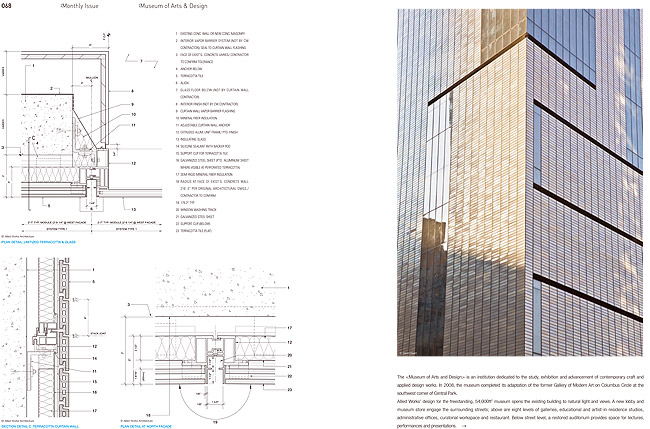
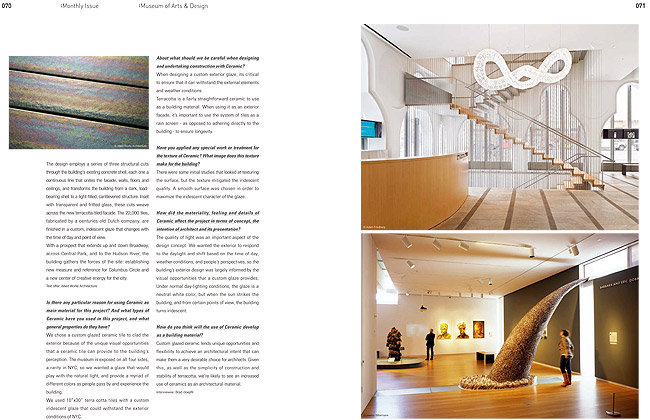
아트 디자인 박물관 <아트 디자인 박물관>은 현대 공예와 응용 디자인 작품들을 연구?전시 및 개발하는 기관이다. 이 박물관은 2008년, 센트럴 파크(Central Park) 남서쪽 모퉁이의 콜럼버스 서클(Colubus circle)에 있던 구(舊) 현대미술관을 개축한 것이다. 54,000ft2 넓이의 단독 건물로 설계한 이 박물관은 기존 건물에 자연광과 시야를 열어준다. 새로운 로비와 박물관 매장은 주변 거리와 관계를 맺고, 건물 상부에는 8개 층의 갤러리와 교육실, 예술가 레지던시 스튜디오, 행정사무실, 큐레이터 업무공간과 레스토랑이 있으며, 지하층에 복원한 강당은 강연과 공연, 발표를 위한 공간을 제공한다. 건물의 기존 콘크리트 외피에는 일련의 세 틈이 관통하도록 설계되었는데, 각 틈이 하나의 연속된 선으로 이어져 입면과 벽체, 바닥, 천장을 통합함에 따라 건물은 하중을 담당하던 기존의 어두운 외피 구조에서 빛이 가득한 캔틸레버 구조로 전환된다. 투명 유리와 소결 유리(fritted glass)를 채워 넣은 이 틈들은 테라코타(terracotta) 타일로 마감한 새 입면을 가로지르며 엮어낸다. 수백 년 된 한 네덜란드 회사가 제작한 22,000 개의 타일에 시간대와 보는 각도에 따라 달라지는 무지갯빛 맞춤유약 처리를 했다. 이 건물은 브로드웨이(Broadway)를 따라 센트럴 파크를 가로질러 허드슨(Hudson) 강 쪽으로 시야가 확장하면서 대지의 여러 힘들을 그러모으는데, 이로써 콜럼버스 서클의 새로운 기준점을 설정하고 뉴욕 시를 위한 새로운 창조적 에너지의 중심을 만든다.
글 제공: 앨리드 웍스 아키텍쳐
이 프로젝트에서 세라믹을 주재료로 사용한 이유는 무엇이며, 사용된 세라믹의 종류와 그 특성에 대해 설명해달라. 우리는 맞춤 제작한 유광 세라믹 타일을 외장재로 선택 했는데, 세라믹 타일이 건물을 시각적으로 특별하게 만들 수 있는 재료였기 때문이다. 이 박물관은 뉴욕 에서는 흔치 않게 사방으로 노출되기 때문에, 유광 처리한 외장재가 자연광과 반응하면서 건물 곁을 지나는 사람들에게 다양한 색으로 보이게 하고 싶었다. 우리는 10”x30” 테라코타 타일에 무지갯빛 맞춤유약을 칠해 뉴욕 시의 외부 환경을 견딜 수 있게 했다. 세라믹을 다루는 건축물의 설계, 시공 과정의 주안점은 무엇이라고 생각하는가? 외장재의 맞춤유약을 계획할 때, 외적 요소와 날씨 조건에 견딜 수 있게 하는 게 매우 중요하다. 테라코타는 건설재료로 사용하기에 상당히 간편한 세라믹 재료다. 테라코타를 외부 입면에 사용할 때 중요한 것은, 타일 시스템을 건물에 바로 부착하는 방식이 아닌 공간을 띄운 방수층(레인스크린)으로서 활용하여 재료의 수명을 보장해야 한다는 것이다. 세라믹의 질감을 위해 어떤 특별한 작업이나 처리를 하였는가? 이 질감은 건축물에 어떤 이미지를 형성 하는가? 초기에 표면 질감을 관찰하는 여러 연구를 했으나, 그런 질감이 무지갯빛 효과를 중화시켰다. 따라서 매끈한 표면을 선택하여 유약의 무지갯빛 특성을 극대화했다. 작품의 개념, 건축가의 의도, 주제 표현 등을 위해 세라믹의 물성, 느낌 또는 디테일이 작품에서 어떤 역할을 하는가? 빛의 질이 설계 개념에서 중요한 요소 중 하나였다. 우리는 외부가 자연광에 반응하면서 하루 중 시간대와 날씨 조건, 사람들의 시선 등에 따라 변화하길 원했기 때문에, 건물의 외장 설계는 맞춤유약이 제공하는 시각적 가능성에 큰 영향을 받았다. 통상적인 자연광 조건에서 유약은 무채색의 백색을 띠지만, 건물에 직사 광선이 닿을 때 어떤 각도에서 보면 건물이 무지갯빛을 띠게 된다. 건축자재로써 세라믹의 쓰임이 어떻게 발전할 것으로 예상하는가? 맞춤제작 유광 세라믹은 건축적 의도를 관철할 수 있는 특별한 가능성과 가변성을 제공하기 때문에, 건축가에게 매우 매력적인 재료일 수 있다. 이와 함께 테라코타의 구조적 단순성과 안정성을 고려해보면, 세라믹은 건축 재료로서 더 많이 사용될 가능성이 높다.
인터뷰이: 브래드 클로필
The (Museum of Arts and Design) is an institution dedicated to the study, exhibition and advancement of contemporary craft and applied design works. In 2008, the museum completed its adaptation of the former Gallery of Modern Art on Columbus Circle at the southwest corner of Central Park. Allied Works’ design for the freestanding, 54,000ft2 museum opens the existing building to natural light and views. A new lobby and museum store engage the surrounding streets; above are eight levels of galleries, educational and artist-in residence studios, administrative offices, curatorial workspace and restaurant. Below street level, a restored auditorium provides space for lectures, performances and presentations. The design employs a series of three structural cuts through the building’s existing concrete shell, each one a continuous line that unites the facade, walls, floors and ceilings, and transforms the building from a dark, loadbearing shell to a light-filled, cantilevered structure. Inset with transparent and fritted glass, these cuts weave across the new terracotta-tiled facade. The 22,000 tiles, fabricated by a centuries-old Dutch company, are finished in a custom, iridescent glaze that changes with the time of day and point of view. With a prospect that extends up and down Broadway, across Central Park, and to the Hudson River, the building gathers the forces of the site: establishing new measure and reference for Columbus Circle and a new center of creative energy for the city.
Text offer: Allied Works Architecture
Is there any particular reason for using Ceramic as main material for this project? And what types of Ceramic have you used in this project, and what general properties do they have? We chose a custom glazed ceramic tile to clad the exterior because of the unique visual opportunities that a ceramic tile can provide to the building’s perception. The museum is exposed on all four sides, a rarity in NYC, so we wanted a glaze that would play with the natural light, and provide a myriad of different colors as people pass by and experience the building. We used 10”x30” terra cotta tiles with a custom iridescent glaze that could withstand the exterior conditions of NYC. About what should we be careful when designing and undertaking construction with Ceramic? When designing a custom exterior glaze, its critical to ensure that it can withstand the external elements and weather conditions. Terracotta is a fairly straightforward ceramic to use as a building material. When using it as an exterior facade, it’s important to use the system of tiles as a rain screen - as opposed to adhering directly to the building - to ensure longevity. Have you applied any special work or treatment for the texture of Ceramic? What image does this texture make for the building? There were some initial studies that looked at texturing the surface, but the texture mitigated the iridescent quality. A smooth surface was chosen in order to maximize the iridescent character of the glaze. How did the materiality, feeling and details of Ceramic affect the project in terms of concept, the intention of architect and its presentation? The quality of light was an important aspect of the design concept. We wanted the exterior to respond to the daylight and shift based on the time of day, weather conditions, and people’s perspectives, so the building’s exterior design was largely informed by the visual opportunities that a custom glaze provides. Under normal day-lighting conditions, the glaze is a neutral white color, but when the sun strikes the building, and from certain points of view, the building turns iridescent. How do you think will the use of Ceramic develop as a building material? Custom glazed ceramic lends unique opportunities and flexibility to achieve an architectural intent that can make them a very desirable choice for architects. Given this, as well as the simplicity of construction and stability of terracotta, we’re likely to see an increased use of ceramics as an architectural material.
Interviewee: Brad cloepfil
건축문화 2016년 7월호 [Monthly Issue]페이지 © 에이엔씨출판(주)